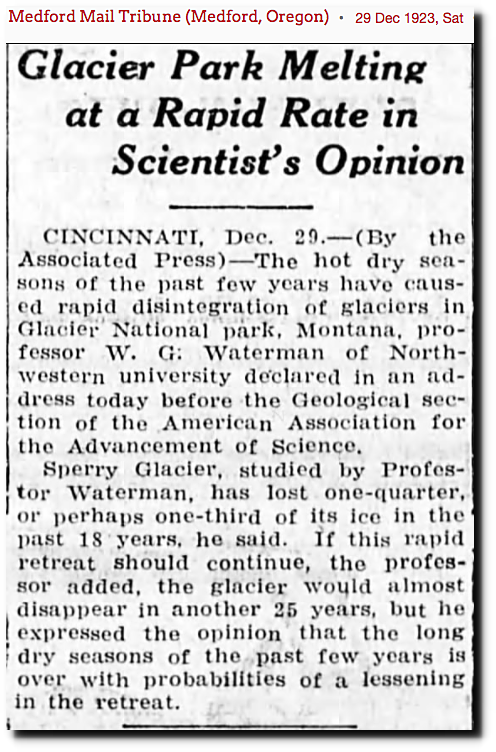According to NOAA and the IPCC, 1923 was one of the coldest years of the last millennium.
Climate at a Glance | Global Time Series | National Centers for Environmental Information (NCEI)
Glaciers were rapidly melting in the official record cold.
“Medford Mail Tribune (Medford, Oregon) – 29 Dec 1923, Sat
Glacier Park Melting at a Rapid Rate in Scientist’s Opinion
CINCINNATI, Dee. 29.—(By the Associated Press)—The hot seasons of the past few years have caused rapid disintegration of glaciers in Glacier National park, Montana, professor W. G: Waterman of North- western university declared in an ad- dress today before the Geological section of the American Association for the Advancement of Science,
Sperry Glacier, studied by Professor Waterman, has lost one-quarter, or perhaps one-third of its ice in the past 18 years, he said. If this rapid retreat should continue, the professor added, the glacier would almost disappear in another 25 years, but he expressed the opinion that the long dry seasons of the past few years is over with probabilities of a lessening in the retreat.”
 29 Dec 1923, Page 5 – at Newspapers.com
29 Dec 1923, Page 5 – at Newspapers.com
“Maitland Daily Mercury (NSW : 1894 – 1939), Saturday 7 April 1923, page 2
NORTH POLE MELTING.
CHANGE OF CLIMATE. MANY GLACIERS VANISHED.
Is the North Pole going to melt en-tirely ? Are the Arctic regions warm-ing up, with prospect of a great cli-matic chaange in that part of the world ? Science is asking these questions (says “Popular Science Siftings”).
Reports from fishermen, seal hunters, and explorers who sail, the seas around Spitzbergen and the eastern Arctic all point to a radical change in climatic conditions, with hitherto unheard-of high temperatures on that part of the earth’s surface. Observations to that effect have covered the last five years during which the warmth has been steadily increasing. In August the Norweg-ian Department of Commerce sent an expedition to Spitzbergen and Bear Island under the leadership of Dr. Adolf Hoel, professor of geology in the University of Christiania, the ob-ject in view being to survey and chart areas productive of coal and other minerals. The expedition sailed as far north as 81 deg. 20min. N. lati-tude in ice free water. Such a thing, hitherto, would have been deemed impossible. The United States Consul at Ber-jen, Norway, Mr. Ifft, also reports the recent extraordinary warmth in the Arctic. He quotes incidentally the statements of Captain Martin In-gehrigststen, a mariner who has sailed those seas for fifty-four years. The captain says that he first
noted an unusual warmth in 1918, and since then temperatures have risen steadily higher. To-day the eastern Arctic is “hardly recognis-able as the same region of 1865 to 1917.” Many of the old landmarks are greatly altered, or no longer exist. Where formerly there were great masses of ice, these have melted away leaving behind them accumulations of earth and stones such as geolo-gists call “moraines.” At many points where glaciers extended far into the sea half a dozen years ago they have now entirely disappeared. The change in temperature has brought great changes in the plant and animal life of the Arctic. For merly vast shoals of whitefish were found in the waters round Spitzber-gen, but last summer the fishermen sought them in vain. SEALS DISAPPEAR.
Seals, which used to be plentiful in those seas, have almost entirely disappeared. It would seem as if the ocean must have become uncomfort-ably warm for some of its denizens which formerly frequented those latitudes, causing them to float northward towards the Pole. On the other hand other kinds of fishes, hitherto unknown so far north have made their appearance. Shoals of smelt have arrived, and immense schools of herring are reported by fishermen along the west coast of Spitzbergen. Formerly the waters about Spitz-bergen have held an even summer temperature in the neighbourhood of 5 degrees above freezing. This year it rose as high as 28 degrees. Last winter the ocean did not freeze over even on the north coast of Spitzber-gen. This is on the authority of Dr. Hoel. This state of affairs is a cause of much surprise and even astonishment to scientists, who wonder whether the change is merely temporary or the beginning of a great alteration of climatic conditions in the Arctic, with consequent melting of the polar ice sheet. ”







Nothing unusual about 1923 in St Cloud Minnesota, which is close to dead center of the North American continent. our temp records go back to the 1880s. 1923 was 4/10ths of a degree warmer than average. in fact the five years prior to 1923 were all above average. nothing cold about them, on average.
The climate in 2024
maybe snow in Scotland in September
https://www.youtube.com/watch?v=TsHKkzrHalA
I think peak hurricane season is September 10th so we’re just about there and finally we’re getting a hurricane… a weak one, but somewhere inside that storm they’ll find a tiny area that they can report having hurricane force winds. so this is the sixth named storm and here it is September 9th. Recall hurricane Katrina came in August and it was the 11th named storm that year. we are way behind. Al Gore wrong again
Winston Smith sleeping on the job again.